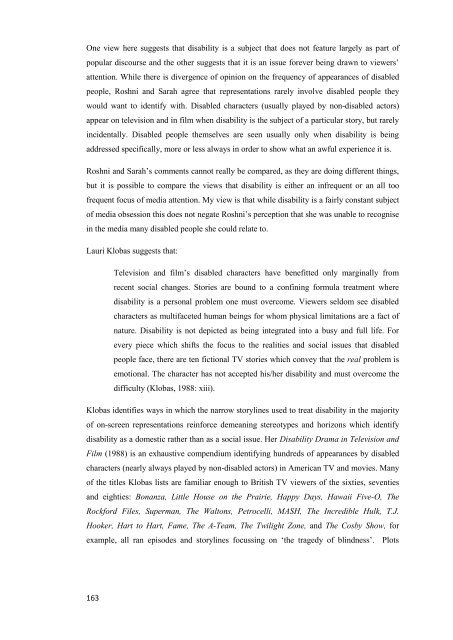A thesis submitted in partial fulfilment of - Etheses - Queen Margaret ...
A thesis submitted in partial fulfilment of - Etheses - Queen Margaret ...
A thesis submitted in partial fulfilment of - Etheses - Queen Margaret ...
You also want an ePaper? Increase the reach of your titles
YUMPU automatically turns print PDFs into web optimized ePapers that Google loves.
One view here suggests that disability is a subject that does not feature largely as part <strong>of</strong><br />
popular discourse and the other suggests that it is an issue forever be<strong>in</strong>g drawn to viewers‟<br />
attention. While there is divergence <strong>of</strong> op<strong>in</strong>ion on the frequency <strong>of</strong> appearances <strong>of</strong> disabled<br />
people, Roshni and Sarah agree that representations rarely <strong>in</strong>volve disabled people they<br />
would want to identify with. Disabled characters (usually played by non-disabled actors)<br />
appear on television and <strong>in</strong> film when disability is the subject <strong>of</strong> a particular story, but rarely<br />
<strong>in</strong>cidentally. Disabled people themselves are seen usually only when disability is be<strong>in</strong>g<br />
addressed specifically, more or less always <strong>in</strong> order to show what an awful experience it is.<br />
Roshni and Sarah‟s comments cannot really be compared, as they are do<strong>in</strong>g different th<strong>in</strong>gs,<br />
but it is possible to compare the views that disability is either an <strong>in</strong>frequent or an all too<br />
frequent focus <strong>of</strong> media attention. My view is that while disability is a fairly constant subject<br />
<strong>of</strong> media obsession this does not negate Roshni‟s perception that she was unable to recognise<br />
<strong>in</strong> the media many disabled people she could relate to.<br />
Lauri Klobas suggests that:<br />
163<br />
Television and film‟s disabled characters have benefitted only marg<strong>in</strong>ally from<br />
recent social changes. Stories are bound to a conf<strong>in</strong><strong>in</strong>g formula treatment where<br />
disability is a personal problem one must overcome. Viewers seldom see disabled<br />
characters as multifaceted human be<strong>in</strong>gs for whom physical limitations are a fact <strong>of</strong><br />
nature. Disability is not depicted as be<strong>in</strong>g <strong>in</strong>tegrated <strong>in</strong>to a busy and full life. For<br />
every piece which shifts the focus to the realities and social issues that disabled<br />
people face, there are ten fictional TV stories which convey that the real problem is<br />
emotional. The character has not accepted his/her disability and must overcome the<br />
difficulty (Klobas, 1988: xiii).<br />
Klobas identifies ways <strong>in</strong> which the narrow storyl<strong>in</strong>es used to treat disability <strong>in</strong> the majority<br />
<strong>of</strong> on-screen representations re<strong>in</strong>force demean<strong>in</strong>g stereotypes and horizons which identify<br />
disability as a domestic rather than as a social issue. Her Disability Drama <strong>in</strong> Television and<br />
Film (1988) is an exhaustive compendium identify<strong>in</strong>g hundreds <strong>of</strong> appearances by disabled<br />
characters (nearly always played by non-disabled actors) <strong>in</strong> American TV and movies. Many<br />
<strong>of</strong> the titles Klobas lists are familiar enough to British TV viewers <strong>of</strong> the sixties, seventies<br />
and eighties: Bonanza, Little House on the Prairie, Happy Days, Hawaii Five-O, The<br />
Rockford Files, Superman, The Waltons, Petrocelli, MASH, The Incredible Hulk, T.J.<br />
Hooker, Hart to Hart, Fame, The A-Team, The Twilight Zone, and The Cosby Show, for<br />
example, all ran episodes and storyl<strong>in</strong>es focuss<strong>in</strong>g on „the tragedy <strong>of</strong> bl<strong>in</strong>dness‟. Plots




